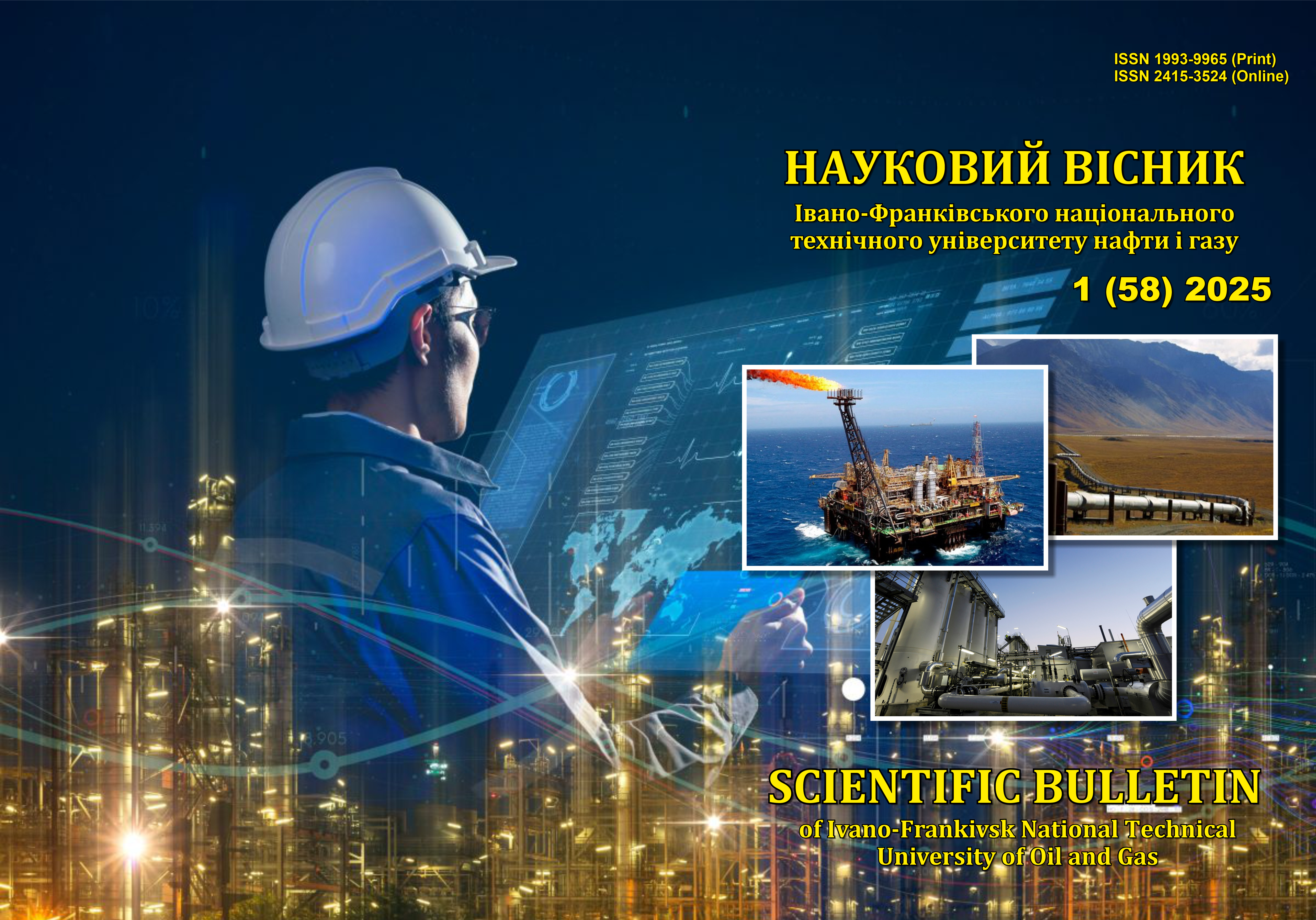THE USE OF NEURAL NETWORKS FOR DESIGN CALCULATIONS OF GAS SUPPLY SYSTEMS IN SETTLEMENTS
DOI:
https://doi.org/10.31471/1993-9965-2025-1(58)-135-147Keywords:
gas pipeline, design calculation, gas distribution system, gas networks, neural networks, deep learning, TensorFlow, Keras.Abstract
The article explores the application of neural networks for performing hydraulic calculations in gas supply systems. The primary objective of the study is to develop a configuration and methodology for applying machine learning to predict design and energy parameters of gas networks, taking into account a wide range of load conditions along pipeline sections. Traditional design methods, including mathematical and hydrodynamic models, have certain limitations in terms of computational speed and adaptability to dynamic changes that may occur under real operating conditions of gas supply systems. The paper proposes the use of neural networks, particularly deep learning techniques, to automate and enhance the design process. The key stages and requirements for training neural networks to solve gas supply system design tasks are defined, including data selection, network architecture configuration, and accuracy assessment of the obtained results. The study highlights the importance of high-quality data preparation and proper parameter selection to ensure model adaptability to the specific conditions of each gas distribution system. One of the critical aspects addressed in the paper is the comparison of neural networks with traditional calculation methods, such as hydrodynamic models and other mathematical approaches. The advantages and limitations of neural networks are evaluated, emphasizing their ability to quickly adapt to changing conditions and to accurately predict parameters of gas supply systems. The article also presents recommendations for integrating neural networks into existing software tools for gas supply system design, combining traditional engineering methods with advanced technologies to improve design efficiency. Special attention is given to the potential of deep learning to enhance prediction accuracy and to optimize design parameters under dynamic operating conditions. Through verification and accuracy assessment of neural network predictions, the study demonstrates that artificial neural networks can reliably forecast design and energy parameters across a broad range of operating modes. The results of the research provide a foundation for the development of new approaches to the design and optimization of gas supply systems that meet current requirements for efficiency, accuracy, and adaptability under variable loads and conditions.
Downloads
References
Ksenych, A. I. & Serediuk, M. D., Vysochanskyi, I. I. (2015) Metodyka hidravlichnoho rozrakhunku kiltsevykh hazovykh merezh nyzkoho tysku z zoseredzhenym vidborom hazu. Rozvidka ta rozrobka naftovykh i hazovykh rodovyshch. 1(54). 97–104. URL: http://elar.nung.edu.ua/bitstream/
/2938/1/4899p.pdf (application date: 17.03.2025) [in Ukrainian]
Ksenych, A.I. (2015) Rozrakhunok hazovykh merezh nyzkoho tysku z urakhuvanniam zoseredzhenoho vidboru hazu po dovzhyni dilianok. Naukovyi visnyk Ivano-Frankivskoho natsionalnoho tekhnichnoho universytetu nafty i hazu. No 1(38). S.101-109. URL: https://core.ac.uk/download/pdf/
pdf (application date: 17.03.2025). [in Ukrainian]
Ksenych, A.I. (2015) Osoblyvosti rozpodilu hazu v systemakh hazopostachannia iz polietylenovykh trub. Naftohazova enerhetyka. Ivano-Frankivskyi natsionalnyi tekhnichnyi universytet nafty i hazu. 1(23). 17-24. URL: https://www.nge.nung.edu.ua/index.php/nge/article/view/328/312 (application date: 17.03.2025). [in Ukrainian]
Serediuk, M. D. & Ksenych A.I. (2015) Osoblyvosti hazodynamichnykh protsesiv u polietylenovykh hazoprovodakh system hazopostachannia. Naftohazova haluz Ukrainy. 3. 28-30. URL: http://elar.nung.edu.ua/bitstream/123456789/276/3/5208p.pdf (application date: 17.03.2025). [in Ukrainian]
K. Wen et al. (2019) An optimization of artificial neural network modeling methodology for the reliability assessment of corroding natural gas pipelines. Journal of Loss Prevention in the Process Industries. 60. 1–8. DOI: https://doi.org/10.1016/j.jlp.2019.03.010. (application date: 14.03.2025).
Deeppipe: Theory-guided neural network method for predicting burst pressure of corroded pipelines. Yunlu Ma et al. ScienceDirect. 2022. 162. 595–609. DOI: https://doi.org/10.1016/j.psep.2022.04.036 (application date: 17.03.2025).
Bin Huang & Jianhui Wang. (2023) Applications of Physics-Informed Neural Networks in Power Systems - A Review. IEEE Transactions on Power Systems. 38. 572–588. DOI: https://doi.org/10.1109/TPWRS.2022.3162473 (application date: 16.03.2025).
Mohammed, S. El-Abbasy & al (2014) Artificial neural network models for predicting condition of offshore oil and gas pipelines. ScienceDirect. 45. 50–65. DOI: https://doi.org/10.1016/j.autcon.2014.05.003 (application date: 11.03.2025).
Zhaoming, Yang et al. (2023) A graph neural network (GNN) method for assigning gas calorific values to natural gas pipeline networks. ScienceDirect. DOI: https://doi.org/10.1016/j.energy.2023.127875 (application date: 12.03.2025).
Xinru, Zhang ta in. (2025) Calculation for critical gas velocity of liquid accumulation in inclined pipelines: a method based on physics-informed neural network. Journal of Pipeline Science and Engineering. DOI: https://doi.org/10.1016/j.jpse.2025.100257 (application date: 22.03.2025).
DBN V.2.5-20:2018. Hazopostachannia. [Chynnyi vid 2019-07-01]. Vyd. ofits. Kyiv. Ukrarkhbudinform. 2019. [in Ukrainian]
Honcharuk, M. I., Serediuk, M. D. & Sheludchenko V. I. Dovidnyk z hazopostachannia naselenykh punktiv Ukrainy. Ivano-Frankivsk : Simyk, 2006. [in Ukrainian]
Keras documentation: Keras 3 API documentation. Keras: Deep Learning for humans. URL: https://keras.io/api/ (application date: 30.01.2025). [in Ukrainian]
Downloads
Published
How to Cite
Issue
Section
License
Авторські права....


1.png)

















